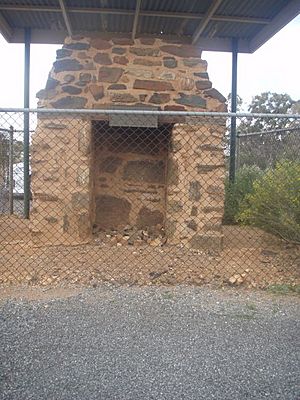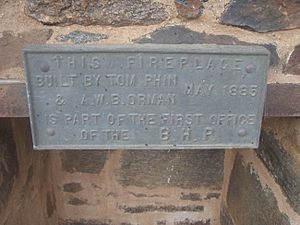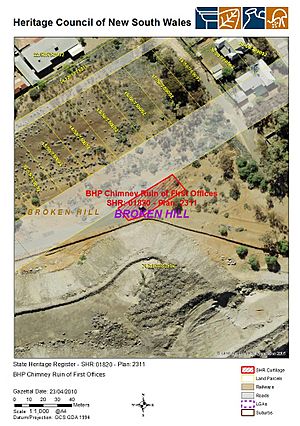First BHP Offices Chimney Ruin facts for kids
Quick facts for kids First BHP Offices Chimney Ruin |
|
|---|---|
 |
|
| Location | Willyama Common, east of corner of Gaffney and Oxide Streets, Proprietary Square, Broken Hill, City of Broken Hill, New South Wales, Australia |
| Built | 1885 |
| Owner | Broken Hill City Council |
| Official name: BHP Chimney Ruin of First Offices; Site of first BHP Offiices; BHP Fireplaces; Chimney ruins | |
| Type | state heritage (archaeological-terrestrial) |
| Designated | 23 April 2010 |
| Reference no. | 1820 |
| Type | Mine office |
| Category | Mining and Mineral Processing |
| Builders | Tom Phin and A.W.B. Orman |
| Lua error in Module:Location_map at line 420: attempt to index field 'wikibase' (a nil value). | |
The First BHP Offices Chimney Ruin is a special historical site in Broken Hill, New South Wales, Australia. It's what's left of the very first offices of BHP, a huge mining company. This chimney was built in 1885 by Tom Phin and A. W. B. Orman. It's also known as the Site of first BHP Offices or BHP Fireplaces. Today, the Broken Hill City Council owns this important ruin. It was added to the New South Wales State Heritage Register on April 23, 2010, because of its historical value.
Contents
History of the Chimney
The Wiljakali People
Long before Europeans arrived, many Aboriginal groups lived in the western plains of New South Wales. The main group around Broken Hill was the Wiljakali people. They lived off the land, but water was often scarce.
Because water was so hard to find, European settlers didn't move into this area as quickly. This meant the Wiljakali people could continue their traditional way of life longer than in other parts of NSW. However, by the 1870s, things began to change.
When droughts hit, Aboriginal people sometimes had to go to stations or missions to find food and water. By the 1880s, many worked on farms or in the new mining industry. Later, some Aboriginal children were sadly removed from their families. This was part of a government policy in the 20th century.
How Broken Hill Began
The name "Broken Hill" was first used by explorer Charles Sturt in 1844. He wrote about a "broken hill" in his diaries while searching for an inland sea. Towns in the western plains, far from big rivers, usually started because minerals were found.
In the 1870s, amazing amounts of gold, silver, copper, and opal were discovered. Broken Hill grew in an area called the "Broken Hill Paddock." This was part of Mount Gipps Station, managed by George McCulloch.
In 1883, three of McCulloch's workers found the first minerals there. Their names were Charles Rasp, David James, and James Poole. They formed a group called the Syndicate of Seven. This group included George McCulloch, Charles Rasp, David James, James Poole, George Urquhart, and George Lind.
They claimed six more mining areas, now known as the Line of Lode. The seventh member of the Syndicate, Philip Charley, found the first big amount of silver in 1885. Soon, a town was planned. At first, Broken Hill was a "shanty town" with many temporary buildings, even a whole suburb called "Canvas Town."
The first survey of Broken Hill started in August 1884. By 1885, the town began to really grow. Before that, it was mostly just scrubland with a few tents. The first proper house was built for Mr. William Jamieson, the manager of the Broken Hill Mining Company. Soon, hotels and stores followed, and Argent Street became a busy place.
The town was officially named "Town of Willyama" in August 1887. Then, in September 1888, it became the "Municipal District of Broken Hill." Finally, in July 1907, it was officially made a "City."
The Important Chimney
The original group of seven miners called their company the Broken Hill Mining Company. After finding lots of silver in early 1885, they hired William Jamieson as manager in April 1885. In June 1885, they officially registered as Broken Hill Proprietary Co. Ltd, or BHP.
The chimney you see today marks the spot of a small hut. This hut was built by Tom Phin and W. B. Orman in May 1885 for William Jamieson. It was located right in the busy mining area, near the "Line of Lode" where the valuable ore was found. For a short time, this hut was the main BHP office. All the mining business happened there.
Even though Jamieson left at the end of 1885, he planned the first big developments for the mine from this very spot. This included setting up the first smelters, which are furnaces used to extract metal from ore. The BHP Chimney is the only part left of that original hut. It dates back to the very year mining began in Broken Hill and when the town started to grow.
Sadly, no photos of the original hut exist.
By 1888, BHP had built wooden staff houses and a nice stone office about 500 meters away. The chimney's site became part of the Block 14 Mine. By the 1890s, all BHP staff housing was in a place called Proprietary Square.
Even in 1908, the chimney was already a ruin. But people knew it was important. It was called "One of the most historical spots on the Hill." People remembered that Mr. William Jamieson and his team lived and worked in a large tent next to this chimney. They made important plans for Broken Hill's future there. BHP even put a wooden fence around it to protect it.
BHP stopped its mining operations in Broken Hill in 1939. In 2001, BHP joined with another company to become BHP Billiton, which is now one of the biggest resource companies in the world.
So, the BHP Chimney is like the birthplace of BHP. This company played a huge role in shaping Australia's mining and industrial history.
The chimney is on public land called Willyama Common. The Broken Hill City Council looks after this land. There are no plans to mine in this specific area.
The top part of the chimney has been rebuilt since 1907. A small tin roof on four wooden poles now protects it. In 2008, the chimney was repaired, and new signs were added to explain its history.
What the Chimney Looks Like
The chimney is a ruin, meaning it's only a part of what it once was. It's the only remaining piece of a worker's cottage. It's built from a mix of stones and bricks.
A new wire mesh fence surrounds the chimney to protect it. A corrugated iron roof, held up by four metal poles, also covers it.
There's an old metal sign that says: This fireplace built by Tom Phin and A.W.B. Orman 1885 is part of the first office of the B.H.P.
There are also newer signs from 2008 that explain more about the chimney and Broken Hill's history. They tell us:
- This stone chimney marks where the first hut for BHP's manager, William Jamieson, was built in May 1885.
- For a short time, this hut was the main BHP office.
- BHP later became part of BHP Billiton, a huge global company. So, this site is like the "birthplace" of BHP.
- Around 1907, BHP put a wooden fence around the chimney to save it. The top part has been rebuilt, and a roof added.
- No photos of the original hut exist, but other old photos show where it was located in the busy mining area.
- The original mining group, the Syndicate of Seven, formed the Broken Hill Mining Company.
- After silver was found, Jamieson became manager in April 1885. He and workers Alf Orman and Tom Phin set up camp here. They built the first structures in Broken Hill, and only this chimney remains.
- The company registered as Broken Hill Proprietary Co. Ltd (BHP) in June 1885.
- Jamieson planned the first mine developments here, including the first smelters.
- By 1888, new offices and staff houses were built further away.
- BHP stopped mining in Broken Hill in 1939.
The chimney was in good shape in 2009 after repairs in 2008. That's also when the new signs were put up.
Why It's a Heritage Site
The BHP Chimney Ruin of First Offices is very important to the history of New South Wales. It's the only part left of the first offices of BHP, a massive Australian mining company.
This chimney was originally part of a worker's cottage. This cottage was one of the first homes built for miners in Broken Hill. It quickly became the first office for Broken Hill Proprietary Ltd (BHP). Today, BHP Billiton is one of the world's biggest mining companies.
Because of this, the chimney represents the very beginning of BHP. This company has helped shape Australia's mining industry, its factories, and even its immigration policies. The fireplace itself was built in May 1885. This was the same year mining started in Broken Hill and when it began to grow into a busy inland town.
The BHP Chimney Ruin of First Offices was officially added to the New South Wales State Heritage Register on April 23, 2010. It met the following important rules:
The place shows how cultural or natural history has developed in New South Wales.
The BHP Chimney Ruin is historically important because it's the only part left of BHP's first offices. BHP has greatly influenced Australia's mining, industry, and immigration. The chimney was part of a worker's cottage that became BHP's first office. It was built in May 1885, the same year mining began in Broken Hill.
The place has a strong connection to important people or groups in New South Wales's history.
The BHP Chimney Ruin is important because of its link to the start of BHP. This company has helped shape Australia's mining and industrial history. The cottage where this fireplace once stood was where BHP's first offices were located.



